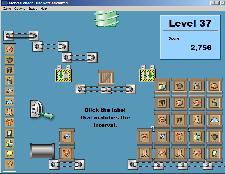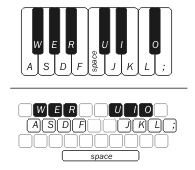
Acoustic Learning,
Inc.
Absolute Pitch research, ear training and more



Click the image for a larger screenshot.
The Ear Training Companion games are designed according to scientific principles of perceptual learning.
All you do is play the games. Your mind will naturally and automatically learn the musical sounds as you play.
"I have been playing the games every day for the last month and have already seen dramatic improvement in my hearing ability."
- Jonathan P.
* * *
Instantly identify any musical note by
its context.
No "reference tone" necessary.
David, a guitarist, explains how harmonic listening is critical to his performance.
So I'm in a band situation and I hear a major 6th ("My Bonnie")-- just knowing this tells me nothing useful in an improvising situation. It could be any of a number of major 6th's in the current improvising key. I need context. I need to hear the pitches harmonically in the key of the improvisation to know anything useful. If you can get this type of listening down, to the point that you just know a note is a maj7 or min3 (or whatever) within the current key (ie. no "My Bonnie" or any other interval based tricks like singing up/down a scale) and you can retain permanent memory of just one key absolutely (say, for example, C major). Then you could technically claim to have perfect pitch.
...I remember reading somewhere that if someone's comparing a note to a reference then some people consider this not to be "real" perfect pitch. But... there's no such comparison, there's just listening in a C major context to a note. Also, someone might argue that it's not perfect pitch because you're identifying a maj6 rather than the note A. But this is just a labeling issue. So you call it "A", well my name for it is "maj6". I can easily just learn the note names rather than interval names and internalize this to the point where I'm labeling notes by name instantaneously.
Rich, also a guitarist, explains how harmonic relative pitch has "opened up" his instrument.
Harmonic relative pitch may explain a difficulty I always had prior to doing any harmonic ear training. When transcribing (or even just singing along with the radio) I would often be confused by a melodic step that would be ascending but depressing (or descending and uplifting) at the same time. I now understand that this happened when a melody would ascend scalar steps, but land on a more harmonically complex note (or the opposite). A P5 to a m6 would be a close interval example. Prior to any harmonic ear training, I would be confused by such an interval. My head would be telling me "up," but my gut would be telling me "down." Wider intervals would simply be confusing as hell. Obviously, the direction would be up, but I'd have no idea by how much.
Now... these steps are much easier. I'm not thinking "a minor second up," I'm thinking "sol to le." It's still relative listening, but the listening part is based on harmony with the common root, which can quickly be translated to scalar steps so my brain can tell my fingers to move up one fret. This has had the ancillary benefit of really opening up the fretboard to me, so I'm improving greatly as a guitar player. I, like many rock guitarists, was really a slave to the "boxes" (fretboard patterns for scales and modes.) Now for me, the boxes are gone, and the entire fretboard is one big land of chromatic possibility.
Phil, a keyboard player, tells how harmonic relative pitch helps him take total control of his instrument.
That is how I navigate while improvising. ...[People say] "the wider the notes, the harder it is to figure." I don't have that problem at all, because I identify notes via harmonic sensing or scale degrees. ...Any note in the scale, no matter how distant, even in an octave 3 or 4 octaves away, is immediately obvious to me-- as long as the key does not change. ...When the key changes... as soon as I discover the key, then I can reset my scale degrees to the new key. ...I came to the conclusion that "I do NOT think in intervals". ...I realized that I stink in naming intervals. Yes, of course I could do it, but not nearly as well as I could find notes on the keyboard. So I said to myself, "Well, what the heck ARE you doing then?" and I realized that I was hearing and identifying notes as scale degrees.
If you learn traditional "intervals", you only know the relationship of each individual note to its immediate neighbor.
If you learn harmonic scale degrees, you know the relationships of every note to the entire context.
The software is really great. At first I was wary about ear training with pictures... but it seems like you've done your homework." - Kyle K.
| - Picture icons for each note - Keyboard training - Game levels teach new skills - Benchmarking - High scores
|
 |
Picture icons for each noteLearn musical sounds without interference! When you play a musical sound and think of the letter "A", you are hearing both of these sounds in your head. Picture icons eliminate the extra letter sounds. Then you can hear the pure musical sounds that you actually want to learn. Once you
know the harmonic scale degrees, The Interval Loader picture icons will help you learn the solfege syllable names:
|
Fingering trainingThe keyboard shortcuts are fully customizable! You'll learn which keys to press, to play by ear, improvise, or follow music.
|
 |
|
Benchmarks and high scoresKeep track of your progress with benchmarks and high scores. See your results in easy-to-read bar charts. Watch your high scores keep getting higher!
|
You will hear recognizable results very quickly, and your perception and performance will continue to improve as your ear learns more and more every day. If you aren't satisfied, for any reason, your purchase is protected by a 100% money-back guarantee.
|
For Macintosh |
For Windows |
For CD-ROM |
For CD-ROM |